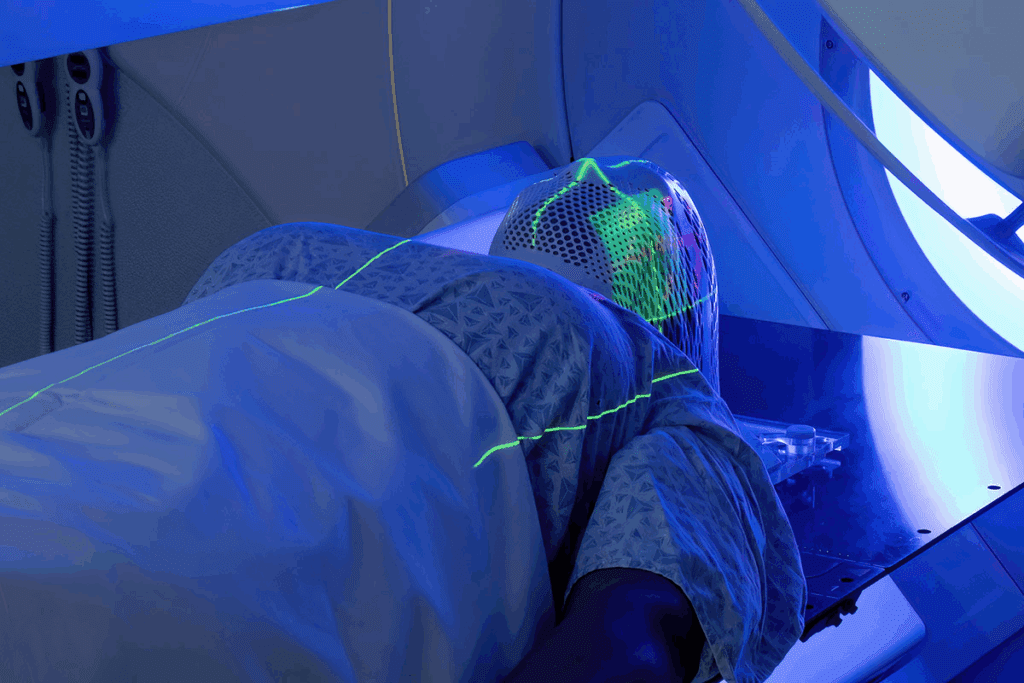Last Updated on November 26, 2025 by Bilal Hasdemir

At Liv Hospital, we see a lot of interest in new, non-invasive cancer therapies. One of these is Rife cancer therapy, which uses devices like the Rife machine. It was created by Royal Raymond Rife. He believed that certain electromagnetic frequencies could find and kill harmful microbes.
Even though regular medicine doesn’t back these ideas, some people and doctors keep using Rife therapy. They see it as an alternative or something to use along with other treatments. In this article, we’ll look into the history, how it was made, and where it stands today.
Key Takeaways
- Rife cancer therapy uses special electromagnetic frequencies to fight cancer-causing microbes.
- The Rife machine, made by Royal Raymond Rife, is designed to find and destroy harmful microbes.
- Mainstream medicine hasn’t proven the effectiveness of Rife therapy.
- Some people use Rife therapy as an alternative or to go along with other cancer treatments.
- This article will dive into the history, development, and current status of Rife cancer therapy.
The History and Development of Rife Cancer Therapy
Rife cancer therapy has its roots in the work of Royal Raymond RifeHe was an American inventor from the early 20th century. His contributions were in microscopy and frequency generation.
Royal Raymond Rife’s Background and Discoveries
Royal Raymond Rife was born on May 16, 1888, in El Paso, Texas. He developed the Rife microscope, a groundbreaking tool for observing microorganisms. His research aimed to find frequencies that could kill pathogens, including cancer cells.
Rife also created a frequency generator. He believed it could emit frequencies that destroy cancer cells safely.
The Original Rife Microscope and Frequency Generator
The Rife microscope was a major leap in microscopy. It could magnify objects up to 17,000 times without harming them. This allowed Rife to study living microorganisms closely, discovering what he called “cancer viruses.”
The frequency generator was key to Rife’s research. It emitted specific frequencies to kill pathogens, including cancer cells. Together, the microscope and generator formed the core of Rife cancer therapy.
Historical Claims of Cancer Treatment Success
Rife and his team reported great success in treating cancer. They claimed to have cured many cases. But the medical community was skeptical, and Rife’s work was eventually silenced.
Despite the controversy, Rife’s work inspired modern alternative cancer therapies. Today, Rife technology is being explored again for its cancer treatment possibilities.
How Rife Cancer Therapy Allegedly Works
Rife Cancer Therapy uses specific frequencies to target and destroy cancer-causing microbes. It’s based on the idea that each pathogen has a unique frequency. When applied, this frequency can disrupt or destroy the pathogen.
The Theory of Resonant Frequencies and Pathogens
Every living organism, including pathogens, vibrates at a specific frequency. Rife Cancer Therapy aims to find and use these frequencies to target and eliminate cancer-causing pathogens. This approach is believed to harm only the pathogens, not the healthy tissue around them.
Resonant frequencies are thought to be unique to each pathogen. This makes them a precise method for targeting cancer cells. By using the correct frequency, the pathogen can be disrupted or destroyed, treating the cancer.
Mortal Oscillatory Rates (MORs) Explained
Mortal Oscillatory Rates (MORs) are specific frequencies believed to be lethal to certain pathogens. Each microbe has a unique MOR. When applied, it causes the microbe to oscillate violently, leading to its destruction.
The concept of MORs is key to Rife Cancer Therapy. It provides a theoretical basis for how the therapy can selectively target and destroy cancer-causing microbes. By identifying the MOR for a specific pathogen, practitioners believe they can effectively treat cancer.
Electromagnetic Frequencies and Their Claimed Effects on Cancer Cells
Electromagnetic frequencies are a core part of Rife Cancer Therapy. Practitioners believe that specific electromagnetic frequencies can target cancer cells and disrupt their growth and proliferation.
The claimed effects of electromagnetic frequencies on cancer cells include:
- Disrupting cell division and growth
- Inducing apoptosis (cell death)
- Enhancing the body’s natural immune response
To illustrate the effects of Rife frequencies on cancer cells, consider the following table:
| Frequency Range | Claimed Effect | Targeted Cancer Cells |
| 100-200 Hz | Inhibiting cell division | Breast cancer cells |
| 400-500 Hz | Inducing apoptosis | Lung cancer cells |
| 700-800 Hz | Enhancing immune response | Colorectal cancer cells |
While Rife Cancer Therapy’s theoretical basis is intriguing, the scientific community debates its efficacy and mechanisms. More research is needed to fully understand its benefits and limitations.
Scientific Evidence Behind Rife Technology for Cancer
The scientific world is closely looking at Rife technology for cancer treatment. Studies and clinical trials are underway to understand its role. The results are mixed, showing both support and doubts about Rife therapy’s effectiveness in fighting cancer.
Current Research and Clinical Studies
In recent years, research on Rife technology has grown. Some studies have shown promising results, like smaller tumors and better patient outcomes. For example, a study in the Journal of Alternative and Complementary Medicine found Rife therapy improved cancer patients’ quality of life when used with traditional treatments.
But it’s important to remember that these studies have limitations. They often have small sample sizes and lack control groups. So, while they offer insights, they don’t prove Rife technology’s full effectiveness.
Case Reports on Circulating Tumor Cells (CTC) Counts
Research on Rife therapy’s impact on circulating tumor cells (CTCs) has caught a lot of attention. CTCs are cancer cells in the blood that can spread the disease. Some reports suggest Rife therapy can lower CTC counts, which might mean the treatment is working.
A case study in a respected journal told the story of a stage IV cancer patient who got Rife therapy. The patient’s CTC count went down, which matched an improvement in their health.
Limitations of Existing Research
While some studies and case reports are interesting, the research has big limitations. Many studies lack strong scientific methods, like randomization and double-blinding. Also, treatment protocols vary, and patient responses differ.
This highlights the need for more thorough, well-designed trials. These trials would help confirm Rife therapy’s safety and effectiveness in cancer treatment.
Mainstream Medical Perspective
From a mainstream medical view, Rife technology is seen as an alternative or complementary therapy. It’s not widely accepted by traditional oncology groups. The main reason is the lack of strong evidence showing it can treat cancer on its own.
Yet, some healthcare providers are willing to consider Rife therapy as a complementary approach. They think it might help when used with traditional treatments. This shows the ongoing debate in the medical field about Rife technology’s place in cancer care.
Types of Rife Machines Available on the Market
The market has many Rife machines for cancer treatment. Each has special features and abilities. They meet different needs and preferences in alternative cancer therapy.
Beam Ray Rife Machines
Beam Ray Rife machines are popular for Rife therapy. They are known for high-quality construction and advanced frequency generation. These machines send precise frequencies to target pathogens.
Copper-Enhanced Rife DevicesCopper-enhanced Rife devices use copper to possibly make therapy more effective. Copper is believed to improve frequency conduction, amplifying treatment efficacy. These devices are liked for their unique Rife technology approach.
Spooky 2 and Other Frequency Generators
Spooky 2 is a well-known frequency generator in Rife therapy. It has many preset programs and lets you create custom frequency sets. Other frequency generators also offer advanced programmability and user-friendly interfaces.
Comparing Features and Capabilities
When picking a Rife machine, compare different devices’ features and capabilities. The table below shows some key aspects of the Rife machines we’ve discussed:
| Device Type | Frequency Range | Programmability | Special Features |
| Beam Ray | 100 Hz – 10 MHz | Yes | High-quality construction, precise frequency control |
| Copper-Enhanced | 20 Hz – 5 MHz | Limited | Copper elements for enhanced conduction |
| Spooky 2 | 1 Hz – 20 MHz | Advanced | Wide range of pre-set programs, custom frequency creation |
Knowing about the different Rife machines and their features helps make informed choices. This is for cancer treatment and overall wellness.
Understanding Rife Frequencies and Programming
Rife frequencies are used in cancer treatment. They work on the idea that each pathogen has a unique frequency. This idea is key to Rife therapy, aiming to kill cancer cells by using their specific frequencies.
How Rife Frequencies Are Determined
Rife frequencies come from research, experiments, and clinical experience. Royal Raymond Rife, the therapy’s founder, spent years finding effective frequencies. A study on the National Institutes of Health’s website shows that frequency therapy can target cancer cells well.
To find Rife frequencies, researchers observe how different frequencies affect microorganisms and cancer cells. Advanced microscopy is often used. This method has led to various frequency sets believed to fight cancer.
Common Frequency Sets for Cancer Treatment
Many frequency sets are used for cancer treatment. They target different cancer types or pathogens. These sets are often ready to use in Rife machines, making treatment easier.
For example, a carcinoma frequency set might use frequencies from 100 Hz to 20,000 Hz. The exact frequencies and how they are used can change based on the device and protocol.
Creating and Using Custom Programs
Some prefer custom programs over preset ones. This means choosing specific frequencies based on the cancer type and stage. It requires understanding Rife frequencies well.
Creating custom programs needs a good grasp of Rife frequencies. It also requires software or device features that allow for customizing frequency sets and protocols.
Resources for Finding Effective Frequencies
There are many resources for finding effective Rife frequencies. These include pre-set programs, user guides, and online databases. Some devices also have software for accessing a wide range of frequency sets.
Research studies and clinical trials also help. They add to the knowledge on effective Rife frequencies. Practitioners and users can use these resources to keep up with new findings and recommendations.
| Frequency Set | Target | Application |
| Carcinoma | Cancer cells in carcinoma | 20 minutes, 3 times a day |
| Sarcoma | Cancer cells in sarcoma | 30 minutes, 2 times a day |
| Leukemia | Leukemia cells | 45 minutes, once a day |
Practical Guide to Rife Machine Use and Safety
Using a Rife machine right means setting it up well, managing sessions, and being safe. We’ll show you how to use it effectively and safely.
Setting Up Your Device for Optimal Results
To use your Rife machine, start by reading the manual. Make sure all connections are tight and you’re using the right settings for your issue. Proper grounding is key to avoiding electrical problems and keeping it safe.
Then, follow the maker’s guide to set up your device. This might mean choosing the frequency, amplitude, and session length. Start with low settings and increase slowly, with a doctor’s advice if you can.
Recommended Session Duration and Frequency
How long and how often you use your Rife machine depends on your health issue and how you react. Sessions can last from 30 minutes to hours. Stick to a regular schedule for best results.
- Start with short sessions (30-60 minutes) and get longer as needed.
- Some plans say to use it several times a day, others once or every other day.
- Keep a log of your sessions to see how you’re doing and adjust your plan.
The “Rife Scan” Process Explained
The “Rife scan” finds frequencies that might help your specific health issue. It sweeps through many frequencies to find the right ones. This scan is done with a special device or software.
During the scan, the device sends out different frequencies. You or a practitioner looks for any changes in symptoms or feelings. Then, you use these frequencies for a custom treatment plan.
Safety Considerations and Possible Side Effects
Rife machine therapy is usually safe when used correctly. But there are some things to watch out for. Always follow the maker’s instructions and talk to a doctor if you have a pacemaker or other implants.
- Start with low intensities and increase as you can handle it.
- Watch how your body reacts during and after sessions, and change your plan if needed.
- Be ready for detox reactions like tiredness, headaches, or nausea.
By knowing and following these tips, you can use your Rife machine safely and effectively. This could help a lot with your cancer treatment.
Purchasing or Renting a Rife Machine for Home Use
Getting a Rife machine for your home needs careful thought. You must think about the cost and who you buy from. It’s key to know the different costs of buying or renting a Rife machine.
Cost Considerations and Options
The price of a Rife machine changes a lot. It depends on the model, its features, and who you buy from. When you’re thinking about buying, look at the upfront cost and any extra costs like upkeep and accessories.
| Device Type | Initial Cost | Maintenance Cost | Total Cost of Ownership |
| Basic Rife Machine | $1,000 – $3,000 | $100 – $300 per year | $1,100 – $3,300 (first year) |
| Advanced Rife Machine | $3,000 – $6,000 | $200 – $500 per year | $3,200 – $6,500 (first year) |
Rental Programs and Trial Periods
If you’re not sure about buying a Rife machine, renting is a good option. Rental programs let you use a device for a set time. You might have the chance to buy it later.
Some sellers also offer trial periods. This lets you try the device before you buy it. It’s great for making sure it fits your needs.
What to Look for When Choosing a Device
When picking a Rife machine, think about a few things. Look at the frequency range, power output, and how easy it is to use. Also, check the seller’s reputation and their customer support.
- Frequency range and programmability
- Power output and its adjustability
- Ease of use and user interface
- Customer support and warranty
Legitimate Vendors vs. Questionable Suppliers
It’s important to know the difference between good sellers and bad ones. Good sellers give clear information about their products. They tell you about the specs, price, and support.
To find a trustworthy seller, read reviews, ask for references, and check their claims. Make sure they talk about the device’s safety and how well it works.
By thinking about these points and doing your homework, you can make a smart choice. Whether you buy or rent a Rife machine, you’ll be well-informed.
Potential Benefits and Limitations of Rife Cancer Therapy
Rife cancer therapy has shown promise, but it’s important to know its benefits and limits. We’ll look at the good and bad sides to help you understand it better.
Reported Benefits for Cancer Patients
Some cancer patients have seen positive effects from Rife therapy. They report feeling less pain and sleeping better. These improvements can make life better for those fighting cancer.
People using Rife machines say they feel less pain and sleep better. While not everyone experiences these benefits, these stories make the therapy appealing.
Quality of Life Improvements
Rife therapy may help cancer patients live better lives. It could reduce side effects from other treatments. This makes life easier during treatment.
Butit’s important to remember that the science backing these claims is not strong. Always talk to your doctor before trying Rife therapy.
Understanding Detoxification Reactions
Some people using Rife therapy go through a “detoxification reaction.” This is when the body gets rid of toxins. Symptoms can include feeling tired, headaches, or nausea, but they usually don’t last long.
Knowing about detox reactions can help you prepare. Always talk to your doctor about any worries you have.
Setting Realistic Expectations
It’s key to have realistic hopes when trying Rife therapy. Some people see big benefits, but others don’t.
Think of Rife therapy as something to add to your treatment, not replace it. Talking to your doctor can help you decide if it’s right for you.
Conclusion: Making Informed Decisions About Alternative Cancer Therapies
Rife cancer therapy has caught a lot of attention as an alternative cancer treatment.Patients need to weighh its benefits and drawbacks carefully.
We’ve looked into Rife cancer therapy’s history, how it works, and the science behind it. Some studies show positive results, but more research is needed to fully understand it.
Before trying Rife cancer therapy, patients should talk to doctors. This helps them know the risks and benefits. It also makes sure it fits into their overall treatment plan.
Patients can make smart choices by looking at all the facts and advice from experts. We suggest patients get help from qualified healthcare providers to deal with the challenges of alternative cancer treatments.
FAQ
What is Rife cancer therapy, and how does it work?
Rife cancer therapy uses electromagnetic frequencies to fight cancer. It’s based on the idea that certain frequencies can kill cancer cells.
Who developed the Rife machine, and what’s its history?
Royal Raymond Rife created the Rife machine. He believed it could cure cancer and other diseases with specific electromagnetic frequencies.
Are Rife machines scientifically validated for cancer treatment?
Some studies have looked into Rife machines for cancer. But mainstream medicine doesn’t fully support them. More research is needed.
What types of Rife machines are available, and how do they differ?
There are many Rife machines, like beam ray and copper-enhanced devices. Each has different features and claimed benefits.
How are Rife frequencies determined, and what’s their significance?
Rife frequencies are believed to target and destroy cancer cells. Practitioners use various methods to find the best frequencies for each patient.
Can I use a Rife machine at home, and what’s involved?
Yes, you can use a Rife machine at home. But it’s important to follow setup and usage guidelines. This ensures safe and effective treatment.
How much does a Rife machine cost, and are there rental options?
The price of a Rife machine varies. Some vendors offer rental or trial periods. This can be a more affordable option.
What are the reported benefits of Rife cancer therapy?
Some people say Rife therapy improves their quality of life and reduces symptoms. But results vary, and more research is needed.
Are there any potential side effects or risks associated with Rife therapy?
Rife therapy is generally safe. But it can cause detox reactions or other side effects in some. Always consult a healthcare professional before starting.
How do I choose a legitimate Rife machine vendor?
Look for vendors with a good reputation and clear product information. Be wary of those making false claims or selling unproven devices.
Can Rife therapy be used in conjunction with conventional cancer treatments?
Yes, Rife therapy can be used with conventional treatments. Bu, it’s important to talk to a healthcare professional to ensure it’s safe and effective.
References
- Sun, Q., et al. (2019). Hyaluronic acid-targeted and pH-responsive drug delivery systems for cancer treatment. European Journal of Pharmaceutics and Biopharmaceutics, 145, 245-257. https://www.sciencedirect.com/science/article/abs/pii/S0142961219305721






